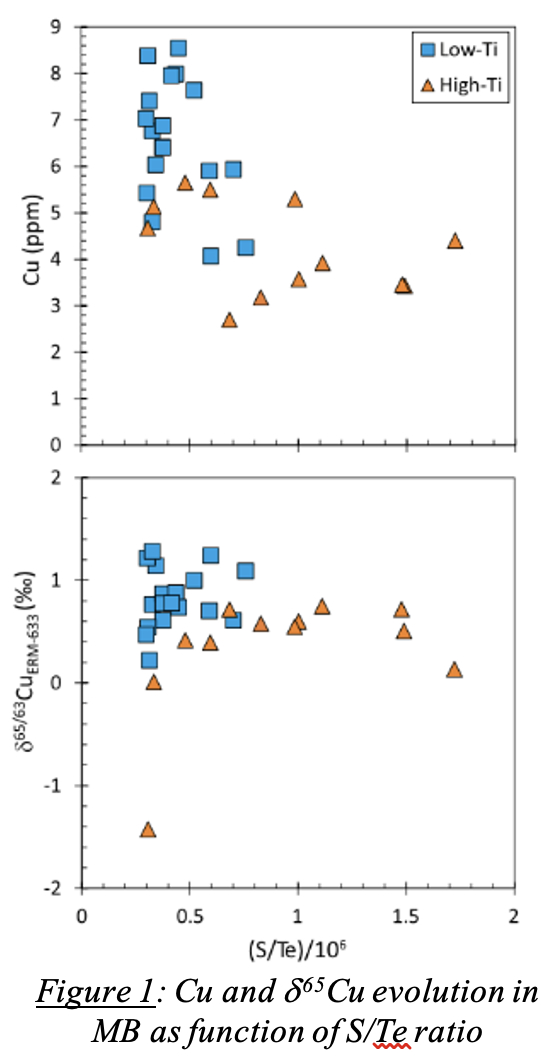Mantle Source Heterogeneities in the Moon Revealed by Copper Isotopic Compositions of Mare Basalts
- Institute of Geological Sciences, Freie Universität Berlin, Berlin, Germany (g.florin@fu-berlin.de)
Introduction: One of the main characteristics of lunar rocks is their strong depletion in moderately volatile elements (MVE) compared to Earth [1], as well as a strong enrichment of heavy isotopes of the MVE, e.g. Cu, Zn, Rb, K, Ga [2-6]. These characteristics have been taken as major arguments in favor of catastrophic outgassing during the Moon forming impact [7], lunar magma ocean (LMO) evolution [8], and/or subsequent magmatic evolution [3]. Due to their ineffectiveness in producing a global MVE depletion and associated isotopic fractionation in the lunar mantle, the two last hypotheses have been questioned in the light of new cutting-edge ab initio calculations [9]. In addition, whereas some of the MVE, e.g. K, Rb, display relatively homogeneous mass-dependent isotopic composition in mare basalts (MB) there appears to be more isotopic heterogeneity for others, particularly Cu [2]. The exact reasons for this isotopic heterogeneity in MB are unknown and may lie in the siderophile/chalcophile behavior of Cu or local volatility-related processes. Here, we present new Cu isotope data for 30 MB and discuss whether their isotopic composition is related to processes during formation of their mantle sources, basalt formation or accompanying volatility-related processes.
Samples and methods: 300 to 500 ng of Cu have been purified from 100 mg low-Ti and high-Ti MB from Apollo 11, 12, 15, and 17 following a chemistry specifically designed for Ti-Fe-rich samples. Copper isotopic ratios were obtained by a NEOMA MC-ICP-MS at Freie Universität Berlin and are reported as delta values (i.e. δ65Cu in ‰) relative to the ERM®-AE633 standard, with uncertainties at 95% confidence intervals.
Results: Compared to low-Ti MB ([Cu]: 4.07 µg/g to 8.55 µg/g; δ65Cu: 0.22 ± 0.04 ‰ to 1.28 ± 0.06 ‰), high-Ti MB have a significantly lighter δ65Cu for a given [Cu] ([Cu]: 2.70 µg/g to 5.65 µg/g; δ65Cu: -1.42 ± 0.10 ‰ to 0.75 ± 0.01 ‰). In addition, most of the MB suites define a narrow range of [Cu]mean and δ65Cumean.
Discussion: Copper content correlates between and within some suites with tracers of magmatic evolution (MgO, FeO, TiO2, Cr/Sm). In contrast, δ65Cu does not correlate with MgO, TiO2, and Cr/Sm and its variation within and between mare basalt suites cannot be explained by silicate fractionation. This strongly suggests that [Cu] changes in different MB suites is a collateral effect of silicate fractionation which agrees with the incompatible nature of Cu, whereas δ65Cu variations in a few suites may reflect mixing of magmas from isotopically different reservoirs and/or local volatility-related processes. However, considering the latter possibility, the range of δ65Cu compositions of MB can only be reproduced if unrealistic initial [Cu] are used, with isotopic fractionation factors very close to unity. Hence, we rule out evaporation during volcanic eruptions as the main process controlling δ65Cu heterogeneity in MB.
Interestingly, MB with the heaviest δ65Cu and highest Mg# have also the lowest S/Cu, S/Se, S/Te, S/Ag and S/Pd ratios (Fig. 1). As S is less chalcophile and siderophile than Cu, Se, Te, Ag, and Pd, and Δ65Cumetal-sulfide > 0 [11], low S/Cu, S/Se, S/Te, S/Ag, S/Pd with heavy δ65Cu in MB should be characteristic of S-poor FeNi alloys while higher ratios generally match lighter δ65Cu expected for sulfides. Such systematics exist from low-Ti to high-Ti MB but not within most of the individual MB suites. Instead, most of the suites define clusters in variation diagrams of Cu and δ65Cu with mass fractions of incompatible elements. This clustering suggests limited fractionation of Cu isotopes, hence an evolution of most MB suites as individual systems, and points towards heterogeneous mantle sources. Thus, the δ65Cu differences between low-Ti and high-Ti MB likely reflect Cu isotope partitioning between silicates melt and alloys evolving from S-poor to S-rich at different stages of LMO crystallization. On the other hand, the more limited δ65Cu variation within MB suites relate to processes during parental melt evolution after melting of lunar mantle sources. Consequently, δ65Cu of lunar MB dominantly record processes prior and/or during solidification of mantle source and their bearing on volatility related processes is limited.

References: 1. LPSE-Team° (1969). Sci 165:1211-1227. 2. G. F. Herzog et al.° (2009). GCA 73:5884-5904. 3. J. M. Day, F. Moynier° (2014). Philos Trans A Math Phys Eng Sci 372:20130259. 4. E. A. Pringle, F. Moynier° (2017). EPSL 473:62-70. 5. K. Wang, S. B. Jacobsen° (2016). GCA 178:223-232. 6. C. Kato, F. Moynier° (2017). Sci Adv 3:e1700571. 7. K. Pahlevan, D. J. Stevenson° (2007). EPSL 262:438-449. 8. C. Kato et al.° (2015). Nat Com 6:7617. 9. N. Dauphas et al.° (2022). Planet Sci Jour 3. 10. P. Gleißner et al.° (2022). EPSL 593. 11. H. M. Williams, C. Archer° (2011). GCA 75:3166-3178.
How to cite: Florin, G., Gleißner, P., and Becker, H.: Mantle Source Heterogeneities in the Moon Revealed by Copper Isotopic Compositions of Mare Basalts, Europlanet Science Congress 2024, Berlin, Germany, 8–13 Sep 2024, EPSC2024-929, https://doi.org/10.5194/epsc2024-929, 2024.